Saukko was in 1930 the world’s smallest submarine. At first this was another covert German project designed at IVS as Pu110, for a quick mobilization defensive U-Boat but she was too small to be adopted, while the Finnish one was designed for Lake Ladoga which imposed by treaty no vessel larger than 100 tonnes. As designed, Saukko displaced 99 tonnes and could be split in two for rail transport. Her armament, range and speed were limited and she never saw service on Ladoga, but the Baltic until 1944. She was discarded in 1946.
Development

The rebirth of the German submarine industry after the ban on submarines imposed by the Versaille treaty left the Reichsmarine to seek for covert operations. A design office was established in the Hague in the Netherlands, officially to provided plans and assistance for the construction of submarines to any interested power. Ingenieurskantoor voor Scheepsbouw came from a program from Admiral Paul Behncke in 1924, with engineers starting working in 1926 with all saved documentation of former WWI submersibles. The Dutch office was financially backed by Vulkan Werft (Hamburg), A.G.Weser/Krupp (Bremen) and Germaniawerft/Krupp (Kiel). IvS started to market its first product by 1925, “Inkavos”, led by Dr. Hans Techel, and via the Istanbul naval attaché receive a first order from Turkey by the intermediary of Admiral Ernst von Gagern. They were built by Fijenoord.
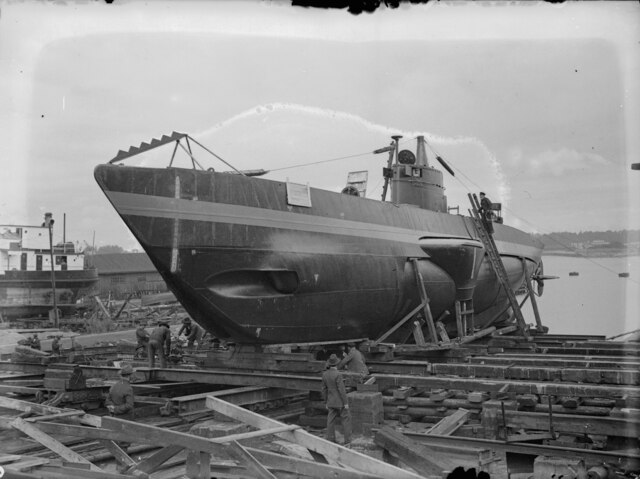
Later in 1928, Finland also was interested, asked for a very small design (Pu110) not exceeding 100 tonnes, to be deployed in Lake Ladoga. This limit was set according to the 1920 Treaty of Tartu. The complete submarine was to be built locally if possible, and then split into separate sections, to be transported on land, by rail and reassembled to operate there. Saukko (“otter”) started construction in 1928 at Sandvikens Skeppsdocka och Mekaniska Verkstad in Helsinki. The design prepared at the Hague was called “Pu110” for a “small, quickly built submarine prototype”. She was launched on 2 July 1930, commissioned on 16 December 1930. At that time she was the world’s smallest submarine, with a tiny pressure hull only capable of housing 15 crew members, and and outer hull reinforced to resist icing. She was armed only by two small tubes (presumably German WWI or Russian torpedoes of this caliber) and a machine gun, but could also lay mines.
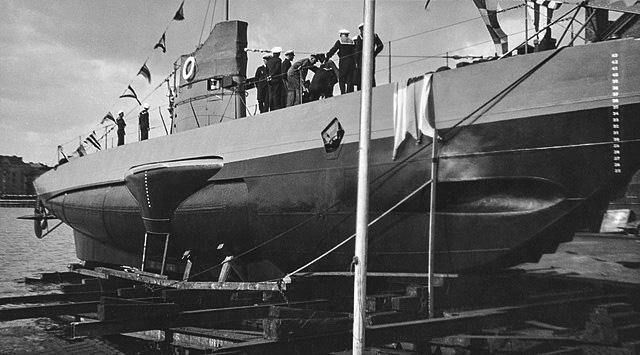
Construction
The shipyard worked in close cooperation with the American Electric Boat Company, from the Dutch design from I.v.S. It’s not clear if the US company never suspected foul play from the Germans, and even if reported, no action was taken. However, the shipyard’s and its subcontractors met a lot of delays and resulted in the poor work quality after delivery. During initial trials there were a lot of issues with the diesel engine and other issues, causing the work to stop as early as May 1929. The situation improved when German, labor from various Yards came to help. Completion after this was swift. As the world’s smallest submarine when completed, she was officially declared at 99 tons in international publications.
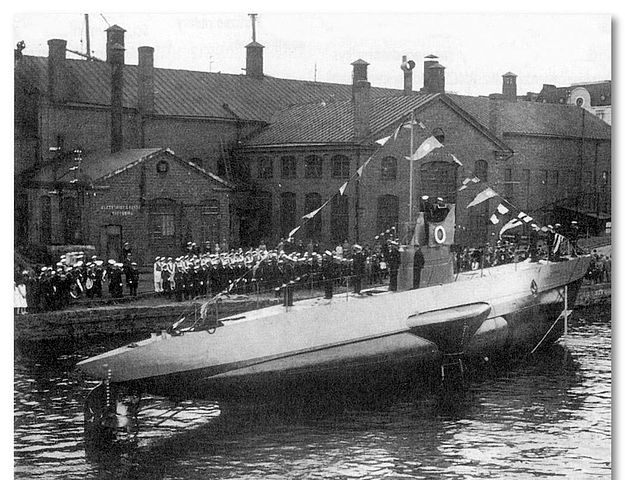
Design
The specifications of Saukko included that the seakeeping properties were to be such that in the Baltic Sea it was possible to operate surfaced in 4-7 force wind at 7 knots. Saukko had endurance of 48 hours and range of 375 nautical miles surfaced. This boat was planned to be a prototype of a rapid-construction boat for the German Navy, but it was discarded from German mobilization plans in 1926. None of the I.v.S other designs included the peculiar and visible saddle tanks built on her hull sides. The original plan was to use wood filling between pressure hull and superstructure to improve stability.
Hull and general design
Saukko was a 99-ton single-hulled submarine, and fast-production boat for Germany in case of war. It was however not approved as way too small to be effective. It was later considered that the smallest practical U-boat should be at least 250 tons. This I.v.S. project was numbered Pu110. Saukko was really made for Lake Ladoga, and its size was the results of treaties forbidding 100+ tons vessels. This forced engineers to create a submarine below or at least no above 99 tonnes. This became world’s smallets and only one ever (so far) designed to operate in a lake. The fact it could be dismantled to facilitate rail transport was a plus, but not knew. Already in WWI the closest U-Boat to compare was the UB-I class, probably the smallest of their day but still much larger (127 tonnes surfaced, 142 tonnes submerged).
Unlike the UB-I (3 sections, each for a flatbed carriage), Saukko’s Hull was split into just two parts plus the conning tower. The engines were located in the aft section and batteries in the front section. So a single train could carry potentially an entire squadron of these. Saukko displaced 99t standard (surfaced) and 136 tonnes submerged. Saukko measured 32.4 x 4.1 x 2.9 meters, so actually more tha the heavier UB-I at 28.10 x 3.15 x 7.30 m (92 ft 2 in x 10 ft 4 in x 23 ft 11 in). The pressure hull was 3,2 meters in diameter, made with 8.5 to 10 mm plating. The outer hull was 5.5 mm thick. The bow and up-amidship section were ice-strengthened with a belt 6 mm thick. There was also a one meter wide keel for ballast. It should be noted that the Ladoga lake (17,700 km2) was on average 47.3 m (155 ft) deep with the lowest points at 230–260 m (750–850 ft).
The pressure hull was built with 38 frames with Pressure bulkheads only between the Central and battery rooms. Up to frame 13 were the Diesel engines and electric motors, to frame 18 was the aft Battery, to frame 27 was the Central, to frame 32 was the Forward battery and to frame 38 was the small Torpedo room.
As designed, Saukko was already very unstable and extra stability tanks were built outside the pressure hull, under the conning tower, giving its peciliar appearance. Tank volumes was starboard (main ballast tank) at 7.800 m3, Port 7.800 m3, Forward 5.441 m3 with a mine and torpedo tank of 1.935 m3 and a mine shaft tank od 1.525 m3, starboard and port stability tanks, a variable ballast tank of 1.185 m3 and a starboard drinking water tank of 0.296 m3, then a port drinking water of 0.296 m3. The Forward trim tank had a capacity of 0.578 m3 and the aft trim tank of 0.588 m3.
Powerplant
It was provided with two diesels for two shafts, with a 9 knots surfaced speed and 5.7 knots underwater speed. At 8 knots range surfaced her range was 450 nm (375 miles) as provided by the single 200 HP Krupp-Germaniawerft Diesel with a capacity of 1.8 tons fuel. This was seconded by two 120 HP electric motors and endurance underwater provided by two 32 battery groups for a range of 45 miles at 4 knots submerged.
Armament
The armament was limited to the small hull, with 450 mm instead of 533 mm tubes, two in the bow. This was completed by a single 12.7 mm machine gun.
The 450 mm torpedo was a Crichton-Vulcan model. The company W:m Crichton & C:o Ab was located in Turku.
There were mounts for two machine guns, on eother side of the CT. tower, bit never installed. She was also the smallest ever minelayer submarine, with three mine shafts in the bow, each carrying three 650 kg mines or one 850 kg and one 650 kg mine. The torpedo tubes could fire 5.7 m long torpedoes.
The central had a single 31 mm diameter Periscope, 5,7 meters tall.
⚙ Saukko specifications |
|
| Displacement | 114 tonnes surfaced, 142 tonnes submerged |
| Dimensions | 32.4 x 4.1 x 2.9 m (106 x 13 x 9.5 ft) |
| Propulsion | 1 shaft Germaniawerft diesel, 200 hp (150 kW)+ electric motor 120 shp (89 kW) |
| Speed | 9 knots (17 km/h; 10 mph) surfaced, 5.7 knots submerged |
| Range | 375 nm (694 km; 432 mi)/8 knots surfaced, 45 km (28 mi)/4 knots submerged |
| Armament | 2× 18 in (460 mm) bow TTs, 12.7 mm machine gun, 6–9 mines |
| Crew | 15 |
Saukko in service

Initial plans to sent Saukko to Lahdenpohja by rail and having her commissioned with the Ladoga flotilla never happened. Both between 1939 and 1940 and between 1941 and 1944 Saukko remained patrolling the Baltic Sea. Soviet intelligence new about the possibility of transferring her to Ladoga lake and so the Soviet Ladoga flotilla was soon to be added a dedicated ASW unit by order of the Baltic fleet Commander-in-Chief N 7, issued in November 23, 1939.
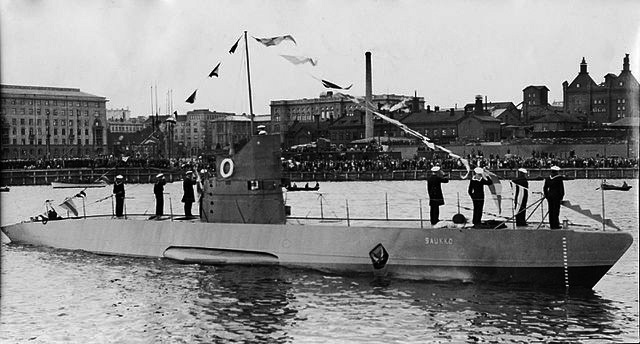
She took part in an important sortie with several motor torpedo boats, towed by the gunboat Karjala to Koivisto on 7 December 1939. It was hoped that Saukko might lay mines or stay in ambush as the war started, and a Leningrad-class destroyer and five other Soviet destroyers arrived and started on 8 Decembe to bombard shell Finnish positions. Saukko however was too slow to catch them. The next day, ice prevented another sortie against returning Soviet ships, however when ice was finally broken, Saukko’s air valves were frozen, so she nearly capsize when trying to submerge to lay a minefield.
There was no more Finnish activity afterwards in the area. During the Continuation War she sas some activity as well. On 3 July 1941 Saukko patrolled off the island of Sommers when spotting two patrol vessels. She fired a torpedo, missed, and was forced to dive and could not stay to observe results. No kill was registered. After the war, Saukko remained in reserve, as under the new treaty she could not be used, and she was scrapped in 1953.
Read More/Src

Vesihiisi class minelayers submarines and tender, prewar.
Books
Sopanen, Akseli (August 2019). “Itämeren pieni vaanija Sukellusvene Saukko alkuideoista poistoon saakka 1921–1953” (PDF). University of Eastern Finland.
Kijanen, Kalervo (1968). Suomen Laivasto 1918–1968 I [Finnish Navy 1918–1968, part I]. Helsinki: Meriupseeriyhdistys/Otava.
Kijanen, Kalervo (1968). Suomen Laivasto 1918–1968 II [Finnish Navy 1918–1968, part II]. Helsinki: Meriupseeriyhdistys/Otava.
“Хильде (1894)” (in Russian). Later in 1941 Hilde was sunk at Hanko.
Polmar, Norman; Noot, Jurrien (1991), Submarines of the Russian and Soviet Navies, 1718–1990: 1718–1990, NIP
Links
on navypedia.org saukko
on web.archive.org Submarines/subconstr.htm
on globalsecurity.org/
hs.fi/helsinki/
web.archive.org/web/ submarines.htm

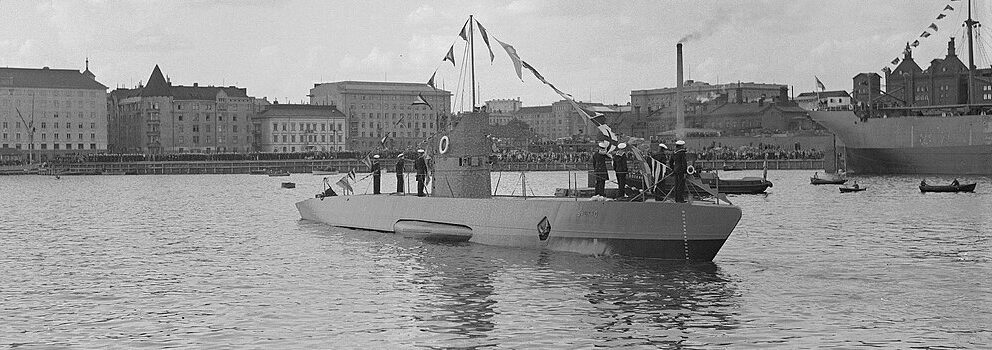

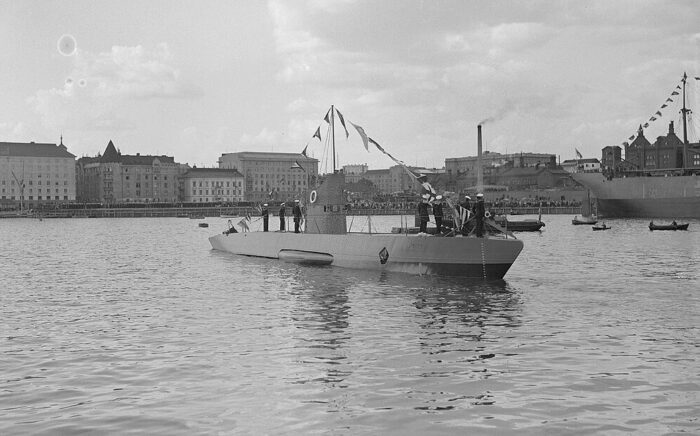
 Latest Facebook Entry -
Latest Facebook Entry -  X(Tweeter) Naval Encyclopedia's deck archive
X(Tweeter) Naval Encyclopedia's deck archive Instagram (@navalencyc)
Instagram (@navalencyc)





 French Navy
French Navy Royal Navy
Royal Navy Russian Navy
Russian Navy Armada Espanola
Armada Espanola Austrian Navy
Austrian Navy K.u.K. Kriegsmarine
K.u.K. Kriegsmarine Dansk Marine
Dansk Marine Nautiko Hellenon
Nautiko Hellenon Koninklije Marine 1870
Koninklije Marine 1870 Marinha do Brasil
Marinha do Brasil Osmanlı Donanması
Osmanlı Donanması Marina Do Peru
Marina Do Peru Marinha do Portugal
Marinha do Portugal Regia Marina 1870
Regia Marina 1870 Nihhon Kaigun 1870
Nihhon Kaigun 1870 Preußische Marine 1870
Preußische Marine 1870 Russkiy Flot 1870
Russkiy Flot 1870 Svenska marinen
Svenska marinen Søværnet
Søværnet Union Navy
Union Navy Confederate Navy
Confederate Navy Armada de Argentina
Armada de Argentina Imperial Chinese Navy
Imperial Chinese Navy Marinha do Portugal
Marinha do Portugal Mexico
Mexico Kaiserliche Marine
Kaiserliche Marine 1898 US Navy
1898 US Navy Sovietskiy Flot
Sovietskiy Flot Royal Canadian Navy
Royal Canadian Navy Royal Australian Navy
Royal Australian Navy RNZN Fleet
RNZN Fleet Chinese Navy 1937
Chinese Navy 1937 Kriegsmarine
Kriegsmarine Chilean Navy
Chilean Navy Danish Navy
Danish Navy Finnish Navy
Finnish Navy Hellenic Navy
Hellenic Navy Polish Navy
Polish Navy Romanian Navy
Romanian Navy Turkish Navy
Turkish Navy Royal Yugoslav Navy
Royal Yugoslav Navy Royal Thai Navy
Royal Thai Navy Minor Navies
Minor Navies Albania
Albania Austria
Austria Belgium
Belgium Columbia
Columbia Costa Rica
Costa Rica Cuba
Cuba Czechoslovakia
Czechoslovakia Dominican Republic
Dominican Republic Haiti
Haiti Hungary
Hungary Honduras
Honduras Estonia
Estonia Iceland
Iceland Eire
Eire Equador
Equador Iran
Iran Iraq
Iraq Latvia
Latvia Liberia
Liberia Lithuania
Lithuania Mandchukuo
Mandchukuo Morocco
Morocco Nicaragua
Nicaragua Persia
Persia San Salvador
San Salvador Sarawak
Sarawak Uruguay
Uruguay Venezuela
Venezuela Zanzibar
Zanzibar Warsaw Pact Navies
Warsaw Pact Navies Bulgaria
Bulgaria Hungary
Hungary

 Bundesmarine
Bundesmarine Dutch Navy
Dutch Navy Hellenic Navy
Hellenic Navy Marina Militare
Marina Militare Yugoslav Navy
Yugoslav Navy Chinese Navy
Chinese Navy Indian Navy
Indian Navy Indonesian Navy
Indonesian Navy JMSDF
JMSDF North Korean Navy
North Korean Navy Pakistani Navy
Pakistani Navy Philippines Navy
Philippines Navy ROKN
ROKN Rep. of Singapore Navy
Rep. of Singapore Navy Taiwanese Navy
Taiwanese Navy IDF Navy
IDF Navy Saudi Navy
Saudi Navy Royal New Zealand Navy
Royal New Zealand Navy Egyptian Navy
Egyptian Navy South African Navy
South African Navy






























 Ukrainian Navy
Ukrainian Navy dbodesign
dbodesign